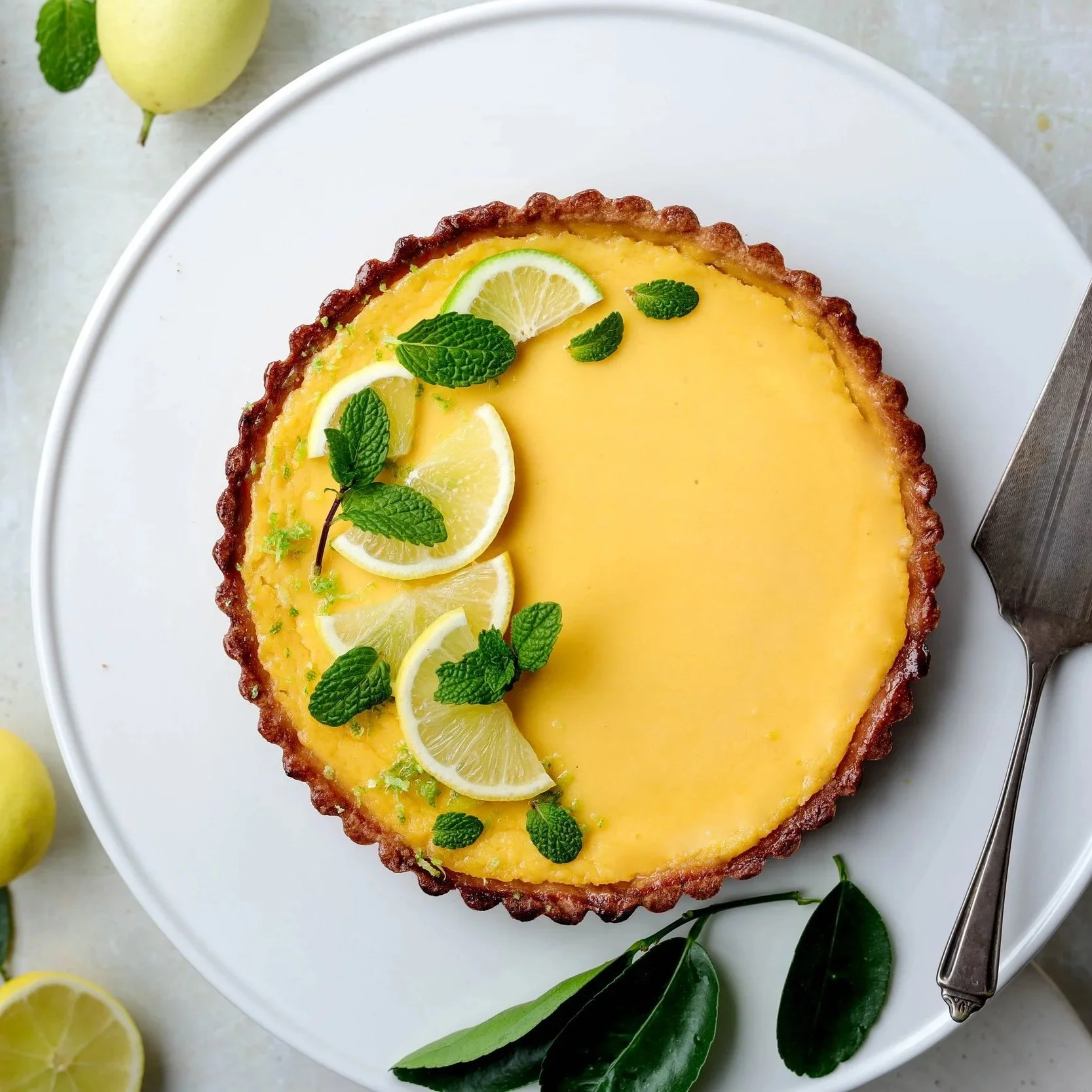easy LEMON TART
An easy lemon tart that is totally foolproofIf there’s one thing I look forward to every year, it’s lemon season which is right now for us. The fruit bowl is overflowing and the question is what can I make with all of these lemons. If you’re finding yourself in the same situation, you can’t go past this French-style lemon tart. After some digging through my books, I landed on the easiest lemon tart recipe. No fiddly curd, no butter, and absolutely no stovetop drama. Honestly, this one’s a game changer: everything happens in the oven, and the filling is a classic lemon flavored custard, brightened up with a little orange for a fresh twist.
What I love most? There’s zero stress—just a handful of ingredients and a quick whisk.It’s foolproof, silky, and you can play around with the flavours however you like. So whether you’ve been put off by the double-boiler routine or just want to let great lemons shine, this is the lemon tart to try.
Makes 1 x 20cm (8in) tart – Serves 4-6
Prep Time: 25 minutes | Bake Time: 20-25 minutes | Cooling: At least 1 hour
INGREDIENTS
For the filling:
3 whole eggs
1 egg yolk
150g caster sugar (¾ cup)
150ml pure cream (heavy cream) (⅔ cup)
150ml freshly squeezed lemon juice (or a mix of citrus juice)
For the tart base:
300 grams sweet shortcrust pastry (pâte sucrée), chilled and ready to roll
Plain flour for dusting
To decorate:
A little clear syrup or maple syrup, for brushing
Slices of lemon, lime zest, fresh mint – optional
MISE EN PLACE
Preheat your oven to 200°C (400°F) convection. Line up a 20cm (8in) loose-bottom tart tin.
If you made your pâte sucrée, keep it chilled but pliable (let it sit out a few minutes if too hard).
Have a rolling pin, plastic wrap, parchment paper, baking beads (or dry beans/rice), and a whisk (preferably silicone) ready. Use non-metal mixing bowls and utensils if possible to avoid a metallic taste in your filling.
METHOD
Let’s start with the base. Sweet shortcrust (pâte sucrée) is a bit fragile—don’t worry if it tears, it patches easily! Lightly flour your work surface and rolling pin. Roll the pastry between two sheets of plastic wrap to prevent sticking. Roll it out larger than your tin—about 24cm (9½ in) in diameter—to allow for the sides.
Once rolled, pop the pastry (still on the wrap) onto a tray and chill in the freezer for 5 minutes to firm up. This makes it much easier to handle.
Lightly butter your tart pan, then dust it with a touch of flour to help prevent sticking. then carefully line your tart tin, gently pressing the pastry into the corners and up the sides. If it cracks, just patch with offcuts and your fingers. Trim any overhanging pastry with a rolling pin or small knife. Prick the base all over with a fork and return to the freezer for another 5 minutes.
Line the chilled pastry with parchment paper and fill generously with baking beads. Bake in the preheated oven (middle rack) for 12–15 minutes, or until the edges are just lightly golden. Remove the beads and paper and leave to cool while you prepare your lemon filling.
For the filling, use a non-metal bowl and whisk if you can (glass or ceramic is best). Crack in the whole eggs and the extra yolk, add the sugar, and whisk well for about a minute until the sugar is mostly dissolved. Whisk in the cream, followed by the lemon juice. The mixture will look pale and slightly foamy.
Skim off any foam with a spoon and strain the mixture through a fine non-metal sieve into a jug. Agin avoid metal utensils to prevent any chance of a metallic aftertaste.
Set your oven to 180°C (360°F), with the fan off ( conventional heat). If you don’t have that option reduce the heat to 160 celcius for a convection oven (fan forced)
Set the tart shell (still in its tin) on a baking tray. Pour in the lemon filling, filling the tart almost to the brim. It’s easiest to do this on the oven rack to avoid spills: fill halfway, slide into the oven, then carefully top up the rest.
Bake for 20–25 minutes, or until just set with a slight wobble in the center. The tart should not bubble or puff
Remove and cool in the tin for 10 15 minutes. Then unmold and leave to cool on a cooling rack. For the neatest slices, chill in the fridge for at least an hour.
To finish, glaze the top of the tart with clear syrup and brush gently over the top to make it glossy. Decorate with a few thin slices of lemon, a little lime zest, or a sprig of mint if you like. You can also just sprinkle powered sugar all over the tart for an easy way out.
TIPS
Avoid high-carbon steel blade to slice your tart so there’s no risk of metallic taste.
This tart is endlessly adaptable—swap lemon and orange for lime, passionfruit, or raspberry.
Don’t skip the chilling steps for the pastry. Cold dough is far easier to handle and helps prevent shrinking.
you must absolutely make sure the filling does not over cook and i just set. over cooking it could develop a metallic taste too if in doubt reduce the temperature of the oven to 170°C (338°F)


